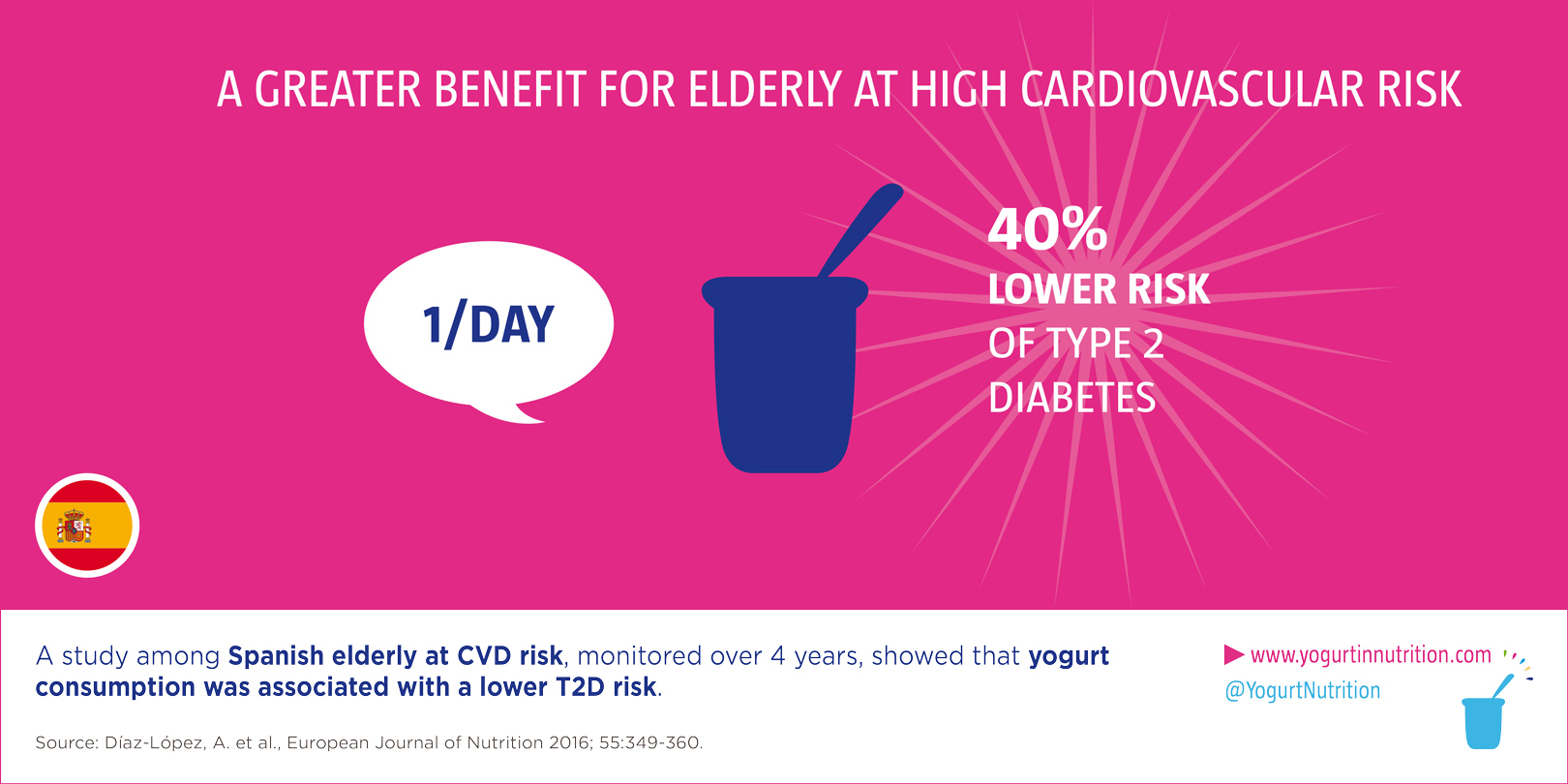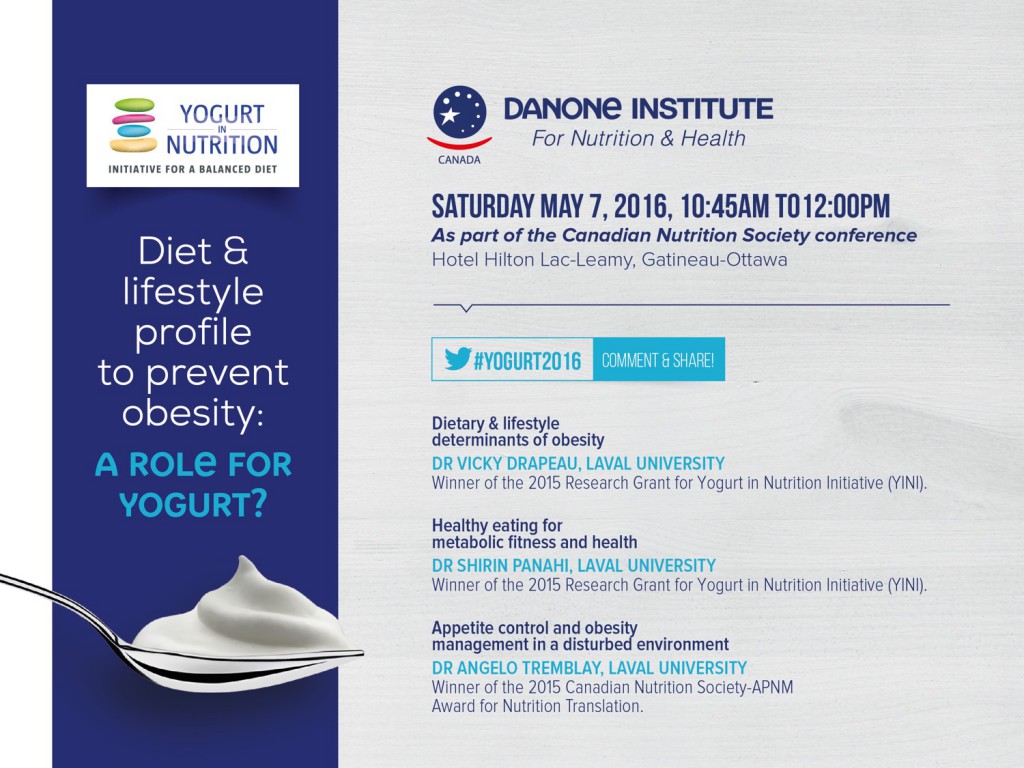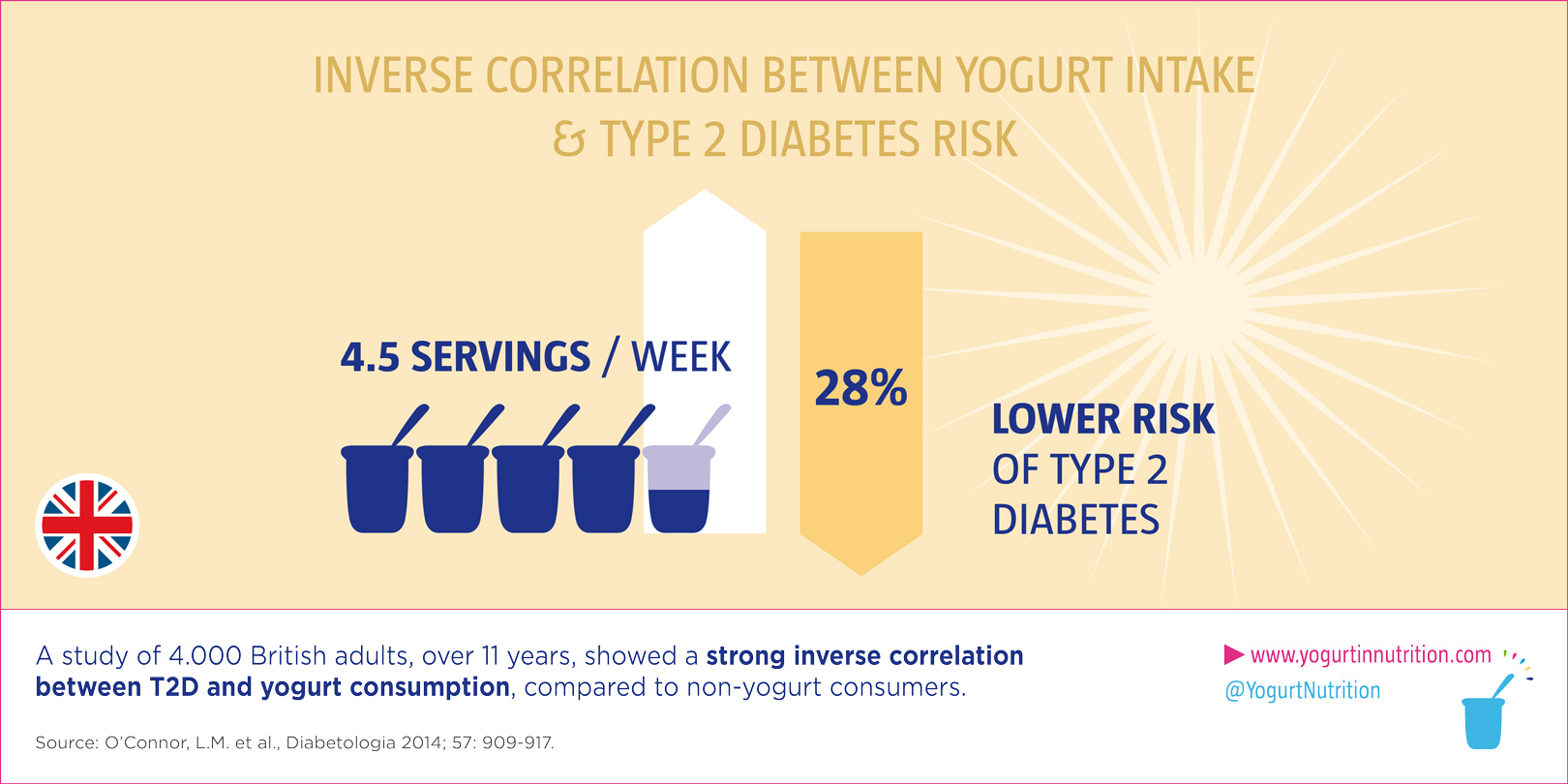Table of contents
Download here the complete infographic ‘Yogurt consumption & risk of Type 2 Diabetes’.

Download here the complete infographic ‘Yogurt consumption & risk of Type 2 Diabetes’.

• 1 knob of butter
• 1 small onion, roughly chopped
• 2 cloves of garlic, roughly chopped
• 1 grated courgette
• 2 bay leaves
• 30 ml (2 tablespoons) of Dijon mustard
• 15 ml (1 tablespoon) of honey or maple syrup
• 2 cans (38 oz.) of lentils, rinsed and drained
• 2 eggs
• 125 ml (½ cup) of grated Parmesan
• 325 ml (1 ⅓ cup) of breadcrumbs
• 75 ml (⅓ of a cup) of Greek yogurt, strained
• 2.5 ml (½ a teaspoon) of Cayenne pepper
• 2.5 ml (½ a teaspoon) of chilli flakes
• Salt and pepper to taste
• In a non-stick pan, melt the butter and sauté the onion and garlic. Add the courgette and bay leaves and continue to cook for 2 minutes and remove the bay leaves.
• Pour the mixture into the mixer bowl and add all the other ingredients. Blend until you get a texture similar to that of minced meat.
• Form patties of around 2 inches (5 cm) in diameter. If the mixture is too sticky, add some breadcrumbs.
• Sauté the patties in a lightly oiled non-stick pan at a medium heat.
• Serve on hamburger buns with curry yogonnaise and sautéed mushrooms.

The scientific symposium will take place at the Hotel Hilton Lac-Leamy, Gatineau-Ottawa in Canada, as part of the Canadian Nutrition Society Conference. Find out more about the official program of the event and download it here.


Several randomized clinical trials shows that individuals, at high risk for developing diabetes, can be given interventions that significantly decrease rate of onset of diabetes.
According to Brown, a compelling body of evidence now unveiled that many of the risks, leading to type 2 diabetes, originate at the very early stages of life and they were influenced by maternal under- or over-nutrition, by diabetes in the mother and by the fetal and post-natal environment. Early life influences, such as maternal under- or over-nutrition, low birthweight and newborn over- feeding, increase the risk of obesity and associated diseases, such as diabetes and cardiovascular disease in the offspring later in life. Therefore, the prevention of diabetes will also start with a healthy pregnancy.
The three largest diabetes prevention studies in the United States have shown beneficial effects of lifestyle interventions. In China, the Da Qing study, including a 20-year follow-up, assessed the long-term effect of lifestyle interventions of diet and exercise. Compared with the control arm, combined lifestyle interventions resulted in a 51% lower incidence of diabetes during an active intervention and a 43% lower incidence over 20 years.
In a similar manner, the Finnish Diabetes Prevention Study concluded that type 2 diabetes can be prevented by changes in the lifestyles of high-risk subjects, defined as those with impaired glucose tolerance, which represented an intermediate category between normal glucose tolerance and diabetes.
In the US, the Diabetes Prevention Program (DPP) indicated that millions of high-risk people can delay or avoid developing type 2 diabetes, by losing weight through regular physical activity and by following a diet low in fat and calories. Weight loss and physical activity lower the risk of diabetes by improving the body’s ability to use insulin and process glucose. The DPP also suggests that metformin can help to delay the onset of diabetes.
Consistent with this modern science, the 2015 Dietary Guidelines Advisory Committee Report emphasizes food-based, healthful diet patterns, as a primary recommendation to address obesity and associated diseases. Evidence also suggests that healthful diet patterns that include yogurt, like the DASH and Mediterranean diets, may be associated with a reduced risk of type 2 diabetes. The explanation is that several different macronutrient distributions in such diet may lead to improvements in glycemic and/or CVD risk factors.

Download here the complete infographic ‘Yogurt consumption & risk of Type 2 Diabetes’.

Annex: Strained Greek yogurt
Greek yogurt has an interesting texture. It is smooth and quite thick. However, some recipes require an even thicker texture, a little like cream cheese or mascarpone. By draining the yogurt you remove part of the whey. In doing so, you get a firmer yogurt.

Constance B. Riggs (@Eatingsoulfully on Twitter) answered 3 questions on Diabetes, putting her talk at #yogurt2016 into perspective.
It has reached epidemic dimensions!
Constance pointed out that Diabetes has both an individual and an economic cost. On one hand, patients are facing individual costs. These can include all possible physical impact of the disease : blindness, loss of kidney functions, loss of limbs, etc. But also, patients face an economic cost, which can be of different nature: lost days of work, time of hospitalization, helping/educating patients, technology, etc.
As a Registered Dietitian, I think of diet as the cornerstone of Diabetes management
According to Constance, diet should be the first place to check for a proper Diabetes control. It’s important, she said, to monitor the amount of food that patients have per meal. It becomes thus possible to evaluate the impact of their diet on blood glucose levels. Research shows that blood glucose kept under tight control is key when it comes to a good monitoring of the disease. This is how, said Constance, we best prevent individual and economic costs.
The way a person with Diabetes should eat, is the same as everyone should!
For Constance, it’s very important not to make the individual feel like he or she has to do something completely different from the rest of his or her family, friends or colleagues. Diet should thus:
Also, Constance reminded us that weightloss is key in managing Type 2 Diabetes. Usually, she said, she invites her patients to target a 7% weightloss, which is a manageable healthy goal. In the end, she concludes, it’s all about healthy eating and physical activity, just the same as for everyone.

Over the last 10–15 years, our understanding of the composition and functions of the human gut microbiota has increased exponentially. To a large extent, this has been due to new ‘omic’ technologies that have facilitated large-scale analysis of the genetic and metabolic profile of this microbial community, revealing it to be comparable in influence to a new organ in the body and offering the possibility of a new route for therapeutic intervention. The good news: the potential of modulating the gut microbiota offers new options in therapy.
There is growing evidence that dysbiosis or microbial disbalance of the gut microbiota is associated with the pathogenesis of both intestinal and extra-intestinal disorders. Intestinal disorders include inflammatory bowel disease, irritable bowel syndrome (IBS), and coeliac disease, while extra-intestinal disorders include allergy, asthma, metabolic syndrome, cardiovascular disease, and obesity. Today, data, coming from animal and human models, suggest that obesity and T2D are associated with a profound dysbiosis. Specifically, patients with T2D have reported alterations in the composition and function of their gut microbiota. This suggests a microbe-mediated mechanism of disease.
Importantly, recent research unveiled that especially butyrate-producing bacteria (which are thus able to exert profound immunometabolic effects), such as Roseburia intestinalis and Faecalibacterium prausnitzii concentrations were lower in T2D subjects. Endotoxaemia, most likely gut-derived, has also been observed in patients with T2D and might play a key role in metabolic inflammation. Also, certain antidiabetic drugs, such as metformin can interfere with the intestinal microbiota. Finally, specific members of the microbiota, such as Akkermansia muciniphila, might be decreased in diabetes and, when administered to murines, exerted antidiabetic effects.
Therefore, as a ‘gut signature’ becomes more evident in T2D, a better understanding of the role of the microbiota in diabetes might pave the way for new therapeutic principles.
Diet is one of the most important factors that has an influence on the gut microbiota. Animal studies have demonstrated that changes in diet may result in changes in the gut microbes, and human studies have confirmed these findings. A few studies have shown that human gut microbiota can adapt and shift within a few days of exposure to a yogurt diet. One study among healthy volonteers, which included yogurt in their diet, demonstrated the presence of food-borne bacteria in their faeces. This indicates that the consumption of yogurt may ensure some advantageous changes to the equilibrium and metabolic activities of the indigenous microbiota. However, recent data showed that long-term diet is particularly strongly associated with gut microbiota composition.

Selected for you this week: Benefits of yogurt to prevent osteoporosis, by WebMD. Every week, we bring you valuable quotes from around the web on yogurt.
Calcium has been shown to have beneficial effects on bone mass in people of all ages, although the results are not always consistent, says Nieves, also an assistant professor of clinical epidemiology at Columbia University. “The combination of calcium and vitamin D has a clear skeletal benefit, provided the dose of vitamin D is sufficiently high,” she adds. And what qualifies as “sufficiently high?” Currently, 400 IU per day is considered an adequate intake of vitamin D for people ages 51-70, Nieves says. (Look for the Daily Value amount listed on food labels.) But more may be better. “This amount is likely to be sufficient for most young adults for skeletal health, although many would argue that for overall health, more than the 400 IU may be required, even at these younger ages,” Nieves said in an email interview. Nieves believes that older people specifically can benefit from more vitamin D. Many dairy products, including some yogurts, are made with added vitamin D. Find out which brands have added vitamin D by checking out the table below, and by reading labels when you shop.“Adequate nutrition plays a major role in the prevention and treatment ofosteoporosis, and the micronutrients of greatest importance are calcium and vitamin D,” says Jeri Nieves, PhD, MS, director of bone density testing at New York’s Helen Hayes Hospital.

Download here the complete infographic ‘Yogurt consumption & risk of Type 2 Diabetes’.

